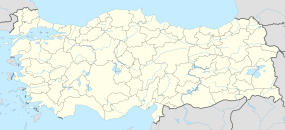Comana (Cappadocia)

Comana
|
|
| Location | Şar, Adana Province, Turkey |
|---|---|
| Region | Cappadocia |
| Coordinates | 38°19′48″N 36°19′48″E / 38.33000°N 36.33000°ECoordinates: 38°19′48″N 36°19′48″E / 38.33000°N 36.33000°E |
| Type | Settlement |
| Site notes | |
| Condition | In ruins |
Comana was a city of Cappadocia (Greek: τὰ Κόμανα τῆς Καππαδοκίας) and later Cataonia (Latin: Comana Cataoniae; frequently called Comana Chryse or Aurea, i.e. "the golden", to distinguish it from Comana in Pontus). The Hittite toponym Kummanni is considered likely to refer to Comana, but the identification is not considered proven. Its ruins are at the modern Turkish village of Şar, Tufanbeyli district, Adana Province.
According to ancient geographers, Comana was situated in Cappadocia (and later Cataonia). Another epithet for the city, found in inscriptions, is Hieropolis 'sacred city', owing to a famous temple of the Syrian Moon goddess Enyo or, in the local language: Ma (cf. Men, the moon goddess of Caria). Strabo and Julius Caesar visited it; the former enters into long details about its position in a deep valley on the Sarus (Seihoun) river. The temple and its fame in ancient times as the place where the rites of Ma-Enyo, a variety of the great west Asian nature-goddess, were celebrated with much solemnity. The service was carried on in a sumptuous temple with great magnificence by many thousands of hieroduli (temple slaves). To defray expenses, large estates had been set apart, which yielded a more than royal revenue. The city, a mere apanage of the temple, was governed directly by the chief priest, who was always a member of the reigning Cappadocian family, and took rank next to the king. The number of persons engaged in the service of the temple, even in Strabo's time, was upwards of 6000, and among these, to judge by the names common on local tomb-stones, were many Persians. Under the Romans the temple was reassigned to Bellona and Lycomedes established as high priest. Emperor Caracalla, made Comana a Roman colony, and the temple-city received honors from later emperors down to the official recognition of Christianity. Comana Chryse, or the golden, appears from one of the Novellae of Justinian (Nov. 31. c. 1), to distinguish it from the Comana in Pontus. It was in the division which he named the Third Armenia, and which, he observes, contained Melitene, near the Euphrates.
...
Wikipedia

